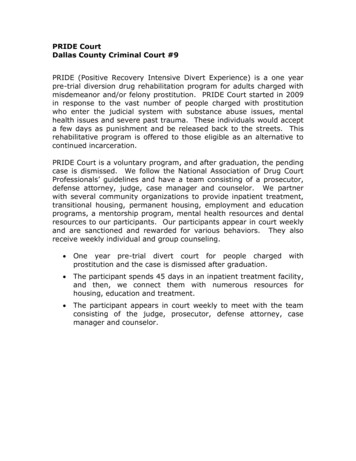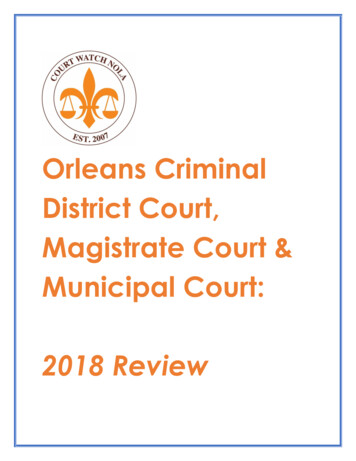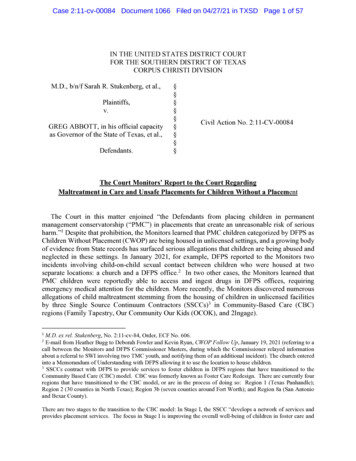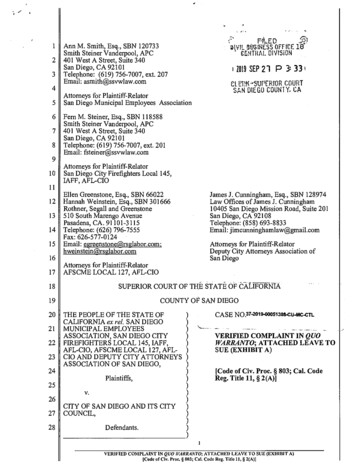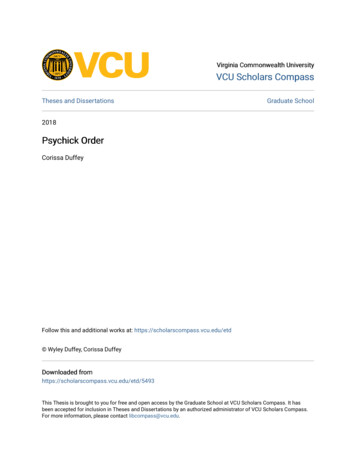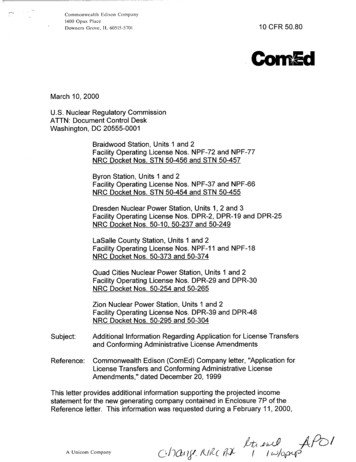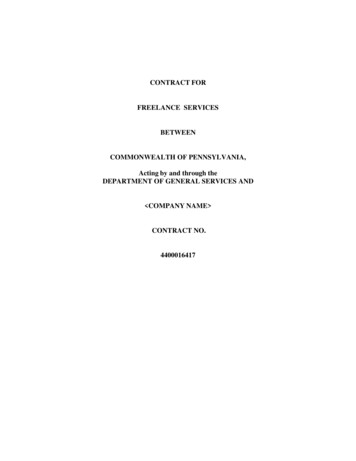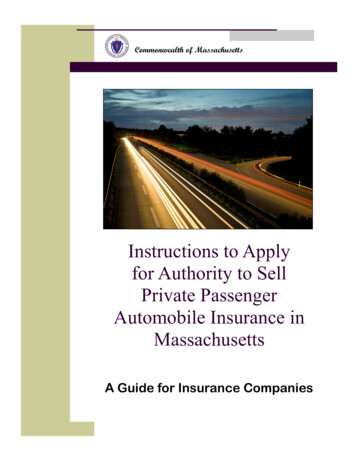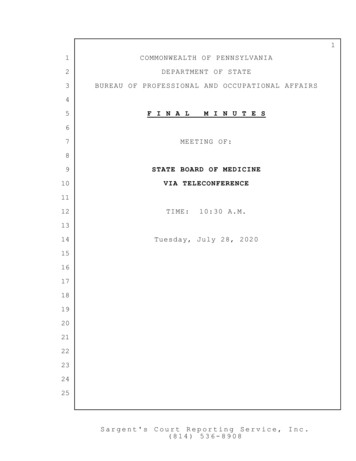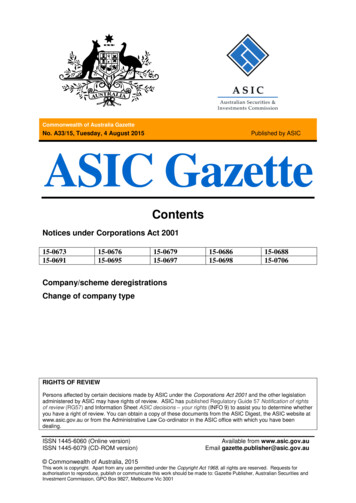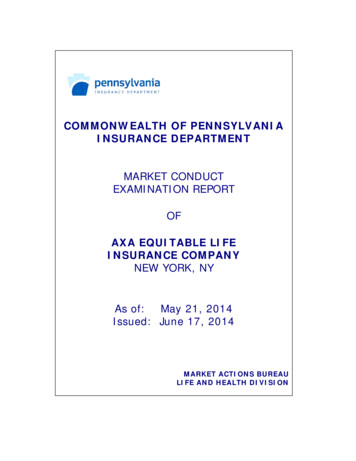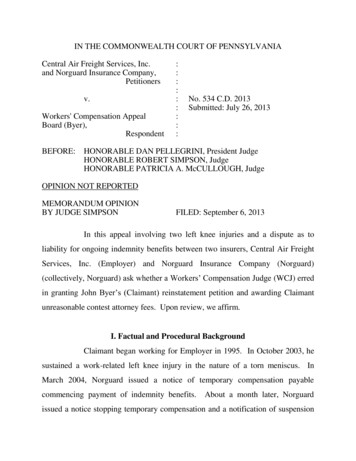
Transcription
IN THE COMMONWEALTH COURT OF PENNSYLVANIACentral Air Freight Services, Inc.and Norguard Insurance Company,Petitionersv.Workers' Compensation AppealBoard (Byer),RespondentBEFORE::::::::::No. 534 C.D. 2013Submitted: July 26, 2013HONORABLE DAN PELLEGRINI, President JudgeHONORABLE ROBERT SIMPSON, JudgeHONORABLE PATRICIA A. McCULLOUGH, JudgeOPINION NOT REPORTEDMEMORANDUM OPINIONBY JUDGE SIMPSONFILED: September 6, 2013In this appeal involving two left knee injuries and a dispute as toliability for ongoing indemnity benefits between two insurers, Central Air FreightServices, Inc. (Employer) and Norguard Insurance Company (Norguard)(collectively, Norguard) ask whether a Workers’ Compensation Judge (WCJ) erredin granting John Byer’s (Claimant) reinstatement petition and awarding Claimantunreasonable contest attorney fees. Upon review, we affirm.I. Factual and Procedural BackgroundClaimant began working for Employer in 1995. In October 2003, hesustained a work-related left knee injury in the nature of a torn meniscus. InMarch 2004, Norguard issued a notice of temporary compensation payablecommencing payment of indemnity benefits.About a month later, Norguardissued a notice stopping temporary compensation and a notification of suspension
because Claimant returned to work with no loss of earnings. A few months later,the parties executed a supplemental agreement for the suspension of benefits.Claimant sustained a second work-related left knee injury in May2009. He filed a claim petition against Employer. The State Workers’ InsuranceFund (SWIF) denied the allegations on Employer’s behalf.1 Further, SWIF allegedthat Claimant’s injury was a recurrence of his October 2003 work injury, andSWIF did not insure Employer at that time.On the same day Claimant filed his claim petition, he also filed areinstatement petition, alleging he “has a recognized injury to his left knee onwhich he suffered a recurrence on 5/11/09. Reinstatement of benefits is requested.”Certified Record (C.R.), Judge Ex. 14.Norguard denied the allegations onEmployer’s behalf. Hearings before a WCJ ensued.About four months after the first hearing, at Claimant’s request, theWCJ issued an interlocutory order under Section 410 of the Workers’Compensation Act (Act).2 That order states, “the evidence thus far presented1Norguard ceased providing Employer workers’ compensation insurance coverage as ofJune 2004.2Act of June 2, 1915, P.L. 736, as amended, 77 P.S. §751. Section 410 states, asrelevant:Whenever any claim for compensation is presented and the only issueinvolved is the liability as between the defendant or the carrier or two ormore defendants or carriers, the referee of the department to whom theclaim in such case is presented shall forthwith order payments to beimmediately made by the defendants or the carriers in said case. After thedepartment's referee or the board on appeal, render a final decision, the(Footnote continued on next page )2
indicates that Claimant suffers a work-related left knee injury which disables him,that knee problem arising out of his employment with [Employer]; and counselfor NorGuard and counsel for [SWIF], pending final disposition agree that a 410Order is appropriate.” C.R. Judge Ex. 10. Thus, the WCJ ordered that indemnityand medical benefits for the left knee be divided between Norguard and SWIF, andthat 20% of the indemnity benefits be deducted and paid to Claimant’s counsel.Before the WCJ, Claimant testified he worked for Employer as a truckdriver. He suffered a left knee injury in October 2003 for which he treated withDr. Mark Perlmutter.In March 2004, Dr. Perlmutter performed surgery onClaimant’s left knee. After the surgery, Claimant experienced some pain, but aftera period of about four or five weeks, he returned to his pre-injury position. In2008, Claimant again experienced pain in his left knee for which he treated withDr. Perlmutter who recommended an MRI and who prescribed and administeredtwo series of injections. Claimant continued to perform his regular duties untilMay 2009. On May 11, 2009, Claimant felt “his knee pop” while getting into histruck. WCJ Op., 1/20/11, Finding of Fact (F.F.) No. 27(b). Shortly thereafter, hebegan treating with David Cooper, M.D. (Claimant’s Physician). On June 10,2009, Claimant’s Physician performed a second knee surgery on Claimant.Claimant did not return to work after June 9, 2009.(continued )payments made by the defendant or carrier not liable in the case shall beawarded or assessed against the defendant or carrier liable in the case, ascosts in the proceedings, in favor of the defendant or carrier not liable inthe case.77 P.S. §751.3
In support of his petitions, Claimant presented the depositiontestimony of his Physician, who is board-certified in orthopedic surgery, and whobegan treating Claimant in May 2009. Claimant’s Physician testified Claimantreported he underwent surgery in 2004, and that he improved “a little” after thesurgery, but he continued to experience problems. F.F. No. 32(d). Claimant alsoreported suffering a second left knee injury in May 2009. Claimant’s Physicianperformed arthroscopic surgery on Claimant’s left knee in June 2009 to remove anew tear in the meniscus suffered in the May 2009 incident. During the course ofthat surgery, Claimant’s Physician found that during the first surgery in 2004, Dr.Perlmutter removed the majority of the posterior of the medial meniscus or theposterior horn of the medial meniscus, which Claimant’s Physician opined, is “themost important part of the meniscus,” F.F. No. 38(d), because of its stabilizingeffect.Claimant’s Physician further opined that between May and earlyAugust 2009, Claimant could not work in any capacity. Between early-August andOctober 7, 2009, Claimant could work in a light-duty capacity, but he remainedunable to perform his pre-injury position. Claimant’s Physician further opined thatas of October 9, 2009, he “considered Claimant’s prognosis to be guarded andwas of the opinion that Claimant’s condition was eventually going to deteriorateto the point where he would need a total knee replacement.”F.F. No. 41.Ultimately, Claimant’s Physician opined, “[a]s a result of the 2003 work injury andthe ensuing surgery by Dr. Perlmutter Claimant has developed post-traumaticarthritis which, as of October 7, 2009, had progressed down to the subcondylarbone, which was necessitating treatment and future care.” F.F. No. 43. Claimant’s4
Physician also opined that the new tear of the anterior medial portion of the medialmeniscus Claimant suffered in May 2009, which was surgically repaired, no longerplayed a role in his current problems.For its part, SWIF presented the deposition testimony of ScottNaftulin, D.O. (SWIF’s Physician), who is board-certified in physical medicineand rehabilitation, and who examined Claimant on one occasion in January 2010.SWIF’s Physician testified Claimant reported a work injury in May 2009.Claimant also reported a previous work injury and surgery, ongoing problems, andtwo courses of viscosupplementation, without benefit.SWIF’s Physicianexplained that the near-total posterior medial meniscectomy after Claimant’s firstinjury led to premature osteoarthritic changes in the knee and to activity-limitingsymptoms that arose before Claimant’s second injury in May 2009.SWIF’sPhysician opined Claimant fully recovered from the May 2009 injury, but he wasunable to return to work because of left knee post-traumatic osteoarthritis.Norguard presented the testimony of Ross Noble, M.D. (Norguard’sPhysician), who is board-certified in physical medicine and rehabilitation, and whoexamined Claimant on one occasion in November 2009. Norguard’s Physicianopined the October 2003 injury did not contribute to Claimant’s disability in 2009because Claimant had a complete resolution of pain following the first surgery in2004. Norguard’s Physician opined that Claimant is disabled in that he cannotperform his pre-injury job; however, he opined Claimant’s ongoing pain andinability to return to work are a result of the May 2009 work injury. He opined the2003 work injury is not causing any current disability.5
Ultimately, the WCJ credited the testimony of Claimant and hisPhysician. Additionally, the WCJ found SWIF’s Physician’s testimony regardingClaimant’s ongoing problems credible and consistent with the totality of therecord. The WCJ rejected the opinions of Norguard’s Physician to the extent theyconflicted with the testimony of Claimant’s Physician and SWIF’s Physician.Based on these determinations, the WCJ found the 2003 and 2009work injuries were to different portions of the knee, with the 2003 injury occurringin the back part of the knee, and the 2009 injury occurring in the front part of theknee.Specifically, the WCJ found, as a result of the October 2003 injury,Claimant tore the posterior horn of the left medial meniscus, which led to removalof the posterior horn in the 2004 surgery. Secondary to the near-total left posteriormedial meniscectomy, Claimant now suffers post-traumatic arthritis, which, as ofOctober 2009, is the current cause of his disability.The WCJ also found Claimant sustained an anterior meniscal tear inMay 2009 from which he recovered as of October 7, 2009. However, Claimantcould not return to full duty work solely because of his post-traumatic arthritis.Based on these findings, the WCJ granted Claimant’s claim petition for a closedperiod, terminating benefits for the May 2009 injury effective October 7, 2009.The WCJ also granted Claimant’s reinstatement petition for the October 2003injury, awarding total disability benefits as of October 8, 2009 and ongoing.In addition, the WCJ found that both SWIF and Norguard engaged inan unreasonable contest and ordered each insurer pay 50% of an attorney fee award6
of 6,645. To that end, the WCJ noted a dispute between insurers on the issue ofliability cannot establish a reasonable contest as to the claimant. See Morgan v.Workmen’s Comp. Appeal Bd. (Strock), 590 A.2d 1375 (Pa. Cmwlth. 1991). BothSWIF and Norguard appealed to the Workers’ Compensation Appeal Board(Board), which affirmed as to the merits, but, as explained in greater detail below,reduced the amount of unreasonable contest attorney fees awarded to 3,180 to bepaid equally by SWIF and Norguard. This appeal by Employer and Norguardfollowed.3II. IssuesOn appeal,4 Norguard presents three issues. First, it contends theBoard erred in affirming the WCJ’s decision that granted Claimant’s reinstatementpetition. Next, Norguard argues the Board erred in determining the opinions ofClaimant’s Physician and SWIF’s Physician constituted competent evidence tosupport the WCJ’s decision. Finally, it asserts the Board erred in determining itpresented an unreasonable contest.III. DiscussionInitially, we note, the WCJ, as the ultimate fact-finder in workers’compensation cases, “has exclusive province over questions of credibility and3After filing their appeal, Employer and Norguard filed an application for supersedeaspending review of their petition for review, which this Court denied.4Our review is limited to determining whether the WCJ’s findings of fact were supportedby substantial evidence, whether an error of law was committed or whether constitutional rightswere violated. Dep’t of Transp. v. Workers’ Comp. Appeal Bd. (Clippinger), 38 A.3d 1037(Pa. Cmwlth. 2011).7
evidentiary weight .” Anderson v. Workers’ Comp. Appeal Bd. (Penn Centerfor Rehab), 15 A.3d 944, 949 (Pa. Cmwlth. 2010). The WCJ’s authority overquestions of credibility, conflicting evidence and evidentiary weight isunquestioned. Minicozzi v. Workers’ Comp. Appeal Bd. (Indus. Metal PlatingInc.), 873 A.2d 25 (Pa. Cmwlth. 2005).The WCJ may accept or reject thetestimony of any witness, including a medical witness, in whole or in part. Id. Weare bound by the WCJ’s credibility determinations. Id.Moreover, “it is irrelevant whether the record contains evidence tosupport findings other than those made by the WCJ; the critical inquiry is whetherthere is evidence to support the findings actually made.”Id. at 29 (citationomitted). We examine the entire record to see if it contains evidence a reasonableperson might find sufficient to support the WCJ’s findings. Id. If the recordcontains such evidence, the findings must be upheld, even though the record maycontain conflicting evidence. Id. Additionally, we must view the evidence in thelight most favorable to the prevailing party and give it the benefit of all inferencesreasonably deduced from the evidence. Wagner v. Workers’ Comp. Appeal Bd.(Anthony Wagner Auto Repairs & Sales, Inc.), 45 A.3d 461 (Pa. Cmwlth. 2012).A. Propriety of Grant of Reinstatement PetitionNorguard first argues the Board erred in affirming the WCJ’s decisionthat granted Claimant’s reinstatement petition. Specifically, Norguard asserts aclaimant who files a reinstatement petition bears the burden of proving thedisability for which compensation was initially paid has recurred or increased,resulting in a loss of earnings.Where, as here, benefits were previously8
suspended, a claimant seeking reinstatement must prove his earning power is onceagain adversely affected by his work injury, and that such disability is acontinuation of that which arose from his original claim. Bufford v. Workers’Comp. Appeal Bd. (North Am. Telecom), 606 Pa. 621, 2 A.3d 548 (2010).Norguard contends this is a heightened burden of proof.Here, Norguard argues Claimant did not present sufficient, competent,or credible medical evidence to prove his disability from the 2003 injury recurredor increased or caused a loss of earnings. Thus, the Board should have reversedthe WCJ’s decision ordering a reinstatement of benefits as of October 8, 2009 andongoing.Norguard maintains a careful review of the record shows thatsubstantial evidence supports a finding that the 2009 incident materiallycontributed to Claimant’s need for treatment and his wage loss; therefore, the 2009injury should have been deemed a new injury, or aggravation. Although the WCJordered SWIF, the carrier liable for the 2009 injury, to pay compensation for aclosed period, the WCJ erroneously granted a termination as to the 2009 injury asof October 7, 2009. Because there was an aggravation, Norguard argues, SWIF isliable for the payment of Claimant’s benefits into the future.In addition, Norguard maintains, the facts show that, while back atwork in his regular duty job, Claimant’s activities increased the degeneration in hisknee. Each day Claimant worked was “an insult and aggravation.” Pet’r’s Br. at17. Each day as a truck driver using a clutch and loading and unloading boxes9
Claimant suffered an aggravation of the 2003 injury. See Reproduced Record(R.R.) at 88a, 185a. In these types of cases, Norguard asserts, the carrier who heldcoverage last would be at risk, which, in this case, is SWIF.Based on these facts, Norguard contends, the WCJ should have deniedreinstatement against Norguard because Claimant did not prove that in 2009 andthereafter, he still suffered symptoms that caused wage loss as a result of the 2003injury. Rather, the facts show Claimant suffered a new injury that materiallycontributed to his symptoms.In Bufford, our Supreme Court clarified the relevant burdens where aclaimant seeks reinstatement of suspended benefits. The modified standard setforth in Bufford is as follows:A claimant seeking reinstatement of suspended benefits mustprove that his or her earning power is once again adverselyaffected by his or her disability, and that such disability is acontinuation of that which arose from his or her original claim.The claimant need not re-prove that the disability arose from hisor her original claim. Once the claimant meets this burden, theburden then shifts to the party opposing the reinstatementpetition. In order to prevail, the opposing party must show thatthe claimant’s loss in earnings is not caused by the disabilityarising from the work-related injury. This burden may be metby showing that the claimant’s loss in earnings is, in fact,caused by the claimant’s bad faith rejection of available workwithin the relevant required medical restrictions or by somecircumstance barring receipt of benefits that is specificallydescribed under provisions of the Act or in this Court’sdecisional law.Bufford, 606 Pa. at 637, 2 A.3d at 558. “In clarifying the relevant burdens, theSupreme Court eliminated the requirement that a claimant seeking reinstatement10
after a suspension of benefits prove that his or her loss of earnings was through nofault of his or her own.” Verity v. Workers’ Comp. Appeal Bd. (Malvern Sch.), 38A.3d 936, 941 (Pa. Cmwlth. 2011) (citing Bufford, 606 Pa. at 635, 2 A.3d at 557).Further, this Court explains:A claimant is not required to produce medical evidence toestablish continuing disability where, as here, benefits havebeen suspended, not terminated. Even if a period of time haspassed, the continuation of the injury is acknowledged by thefact that benefits have been merely suspended, and theemployer has not moved to terminate its liability for theirpayment.Even where a reinstatement petition has been filedfollowing a suspension, the burden is on the employer, in thenature of an affirmative defense, to demonstrate that thedisability is, in fact, attributable to a new injury for which adifferent employer might be liable. This is because apresumptive partial disability exists whenever there is anagreement to suspend compensation.McNulty v. Workers’ Comp. Appeal Bd. (McNulty Tool & Die), 804 A.2d 1260,1263-64 (Pa. Cmwlth. 2002) (citations omitted).In addition, as to the distinction between an “aggravation” and a“recurrence,” this Court explains:If an incident materially contributes to a previous workrelated injury, a new injury, or aggravation, has occurred.Therefore, the employer at the time of the aggravation is liablefor the payment of a claimant’s compensation benefits.However, if a compensable disability results directly from aprior injury but manifests itself on the occasion of anintervening incident, which does not contribute materially to thedisability, then the claimant has suffered a recurrence and the11
employer at the time of the initial injury is responsible for thepayment of benefits. If the sequence of events is not sufficientto establish whether a claimant has suffered an aggravation or arecurrence, unequivocal medical testimony is essential.Id. at 1264 (citations omitted). Whether a disability results from an aggravation ofa pre-existing condition or is a recurrence of a prior injury is a question of fact forthe WCJ to determine. Reliable Foods, Inc. v. Workmen’s Comp. Appeal Bd.(Horrocks), 660 A.2d 162 (Pa. Cmwlth. 1995).Applying these principles here, Claimant sustained an October 2003left knee injury for which he initially received indemnity benefits, followed by asuspension of benefits based on his return to work. See R.R. at 138a. In May2009, Claimant sustained a “new” injury to a “different” portion of the left knee.F.F. Nos. 50, 60. In resolving the factual issue of which injury caused Claimant’scurrent, ongoing disability, the WCJ made the following pertinent findings (withemphasis added):43. I find as a fact that: As a result of the 2003 workinjury and the ensuing surgery by Dr. Perlmutter the Claimanthas developed post traumatic arthritis which, as of October 7,2009, had progressed down to the subcondylar bone, which wasnecessitating treatment and future care.([Claimant’sPhysician’s] deposition, pg 17, lines 20-24; pg 31, line 17-pg 32line 3).44. I find as facts that: (a) The Claimant was completelydisabled by the May 11, 2009, work injury until August 6,2009, when Dr. Cooper released Claimant to perform light dutywork. (b) Subsequent to October 7, 2009, when the Claimantremained released to return to work light duty, the cause of hisimpairment, i.e., his ability to only work light duty, was posttraumatic arth
Services, Inc. (Employer) and Norguard Insurance Company (Norguard) (collectively, Norguard) ask whether a Workers’ Compensation Judge (WCJ) erred in granting John Byer’s (Claimant) reinstatement petition and awarding Claimant unreasonable contest attorney fees. Upon review, we affirm. I. Factual and Procedural Background
